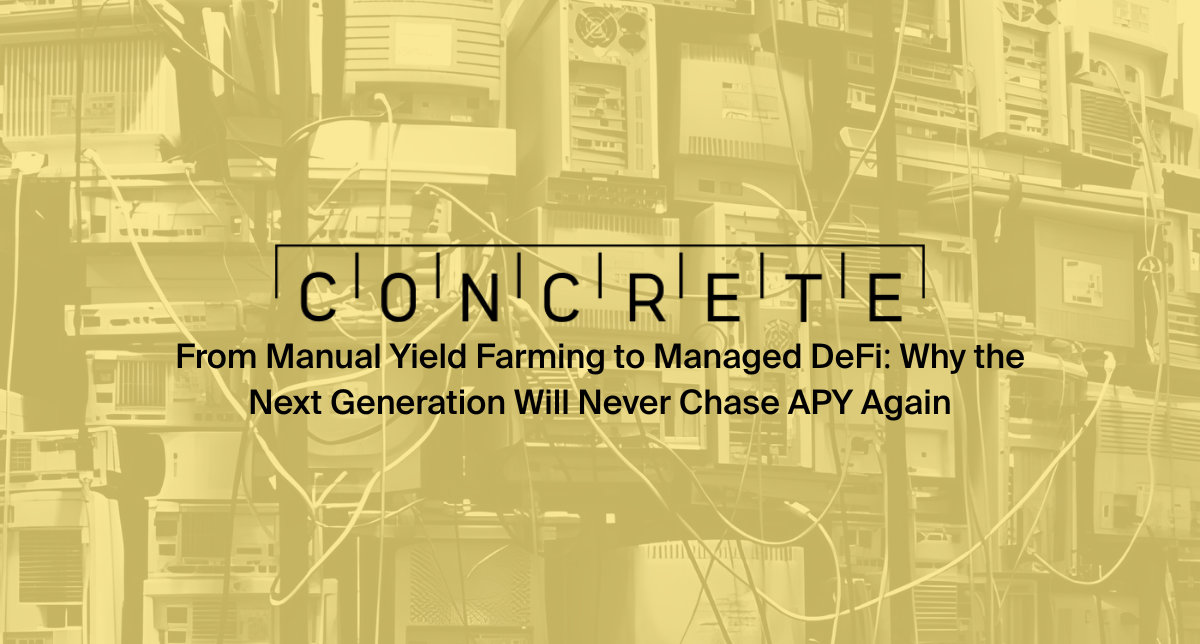Blog

From Manual Yield Farming to Managed DeFi: Why the Next Generation Will Never Chase APY Again
Concrete is building this managed layer, where capital can move at market speed with transparent, on-chain controls and built-in risk frameworks. The future is not about chasing APY. It is about engineered yield.
The Shift DeFi Has Been Waiting For
For years, yield farming rewarded whoever could click the fastest. Capital bounced from pool to pool, chain to chain, chasing the next temporary APY spike.
It worked until it didn’t. High gas fees, impermanent loss, unsustainable emissions, and unstable liquidity meant most farmers earned far less than the dashboards promised.
Institutional allocators saw the opportunity. They also saw the operational burden. Modeling dozens of pools, monitoring emissions schedules, managing collateral risk, and rebalancing constantly is not a sustainable workflow.
The industry needed an upgrade.
Welcome to the vault era.
The End of Manual Yield Farming
Manual farming created asymmetric conditions. Retail users bore the complexity, while professional desks used models and automation to extract more stable returns.
Common problems included:
1. Inflated Headline APYs
A 200 percent APY often translates to a fraction of that once you account for:
- Gas fees
- Slippage
- Volatile reward tokens
- Liquidity dilution
2. Continuous Operational Load
Capital had to be monitored constantly. Allocators spent more time maintaining positions than evaluating new opportunities.
3. Unsustainable Reward Programs
Emissions-driven yields collapsed once incentives ran out. Pools emptied overnight.
4. Fragmented Risk Management
Every pool came with a different set of smart contract risks, liquidity assumptions, and oracle dependencies.
For allocators running real capital, this was a structural barrier to scale.
The Vault Era: DeFi’s Institutional Upgrade
Vault architecture introduced an automated layer that standardized what used to require spreadsheets, bots, and constant monitoring.
A modern vault handles:
- Allocation
- Rebalancing
- Reward harvesting
- Auto-compounding
- Strategy rotation
- Risk monitoring
How Vaults Work
Users deposit a token. The vault manages it across diversified, audited strategies such as:
- Lending markets
- DEX liquidity
- Basis trading
- Delta-neutral positions
- Restaking and staking opportunities
- Structured yield strategies
This makes DeFi feel less like manual trading and more like professional portfolio management. The parallels to TradFi are clear:
- ETFs
- SMAs
- Fund-of-funds
- Quant strategies
Why the Next Generation of DeFi Users Will Never Chase APY
The early DeFi community measured success by the biggest APY they could find. The next generation will measure it by modeled, risk-adjusted performance.
What they expect:
1. Stability Over Speculation
Sustainable returns beat temporary emissions.
Allocators want engineered yield, not hype-based incentives.
2. Real Risk Frameworks
Capital committees need visibility into:
- Drawdown limits
- Smart contract risk
- Liquidity assumptions
- Position-level transparency
- Expected return models
3. One-Click Exposure
Depositors should access multi-strategy yield without juggling wallets, bridges, or dashboards.
4. Fully Transparent Systems
Every move should be on-chain.
Every strategy should be auditable.
Every update should be traceable.
The future is not about speculation. It is about a consistent yield backed by transparent math.
Inside Concrete’s Vault Architecture
Concrete’s Earn V2 infrastructure introduces the structure institutions typically look for without sacrificing user experience.
Role-Based Automation
Strategic decisions and day-to-day operations are cleanly separated:
- Governance roles control high-level allocation frameworks.
- Operator roles execute daily actions like harvesting or rebalancing.
- Automated scripts move capital at market speed within defined risk parameters.
This reduces human error and reduces the operational bottlenecks that slow down traditional DeFi strategies.
Multi-Strategy Exposure
A single deposit can be deployed across:
- Lending markets
- Restaking ecosystems
- DEX liquidity
- Market-neutral strategies
- Structured products
Diversification is native to the system.
On-Chain Transparency
On-chain allocation and movement within the vault is visible publicly.
Institutional allocators can evaluate the strategy with the same rigor they apply to on-chain funds and quantitative managers.
Why This Shift Matters for Institutions
Institutions do not scale on manual workflows. They scale on systems.
Managed DeFi delivers:
- Systematized operations
- Lower volatility profiles
- Better capital efficiency
- Reduced transaction overhead
- Fewer timing errors
- Clear risk governance
Most importantly, it transforms DeFi yield into something that can be evaluated within institutional mandates.
Tip
If you are evaluating vaults, look for real risk engineering. Any vault can chase yield. Only engineered vaults are designed to preserve it.
The Managed Future of DeFi
Manual farming was an essential chapter. It brought liquidity, experimentation, and rapid innovation.
But it was never designed for scale.
The next era is defined by intelligent, automated, data-driven vault systems that transform DeFi from a speculative playground into a mature yield market.
Concrete is building that infrastructure. Not to replace the creativity of early DeFi, but to channel it into systems that institutions can evaluate and choose to trust.
The math has caught up with the marketing. The systems have caught up with the strategies. And the future of DeFi yield will not be manual.
It will be managed.
-----------
¹References to “engineered yield”, “sustainable yield”, or “preserve yield” describe design goals, not guarantees. DeFi strategies involve risk, including possible loss of principal, market volatility, smart-contract vulnerabilities, counterparty risk, and operational risk. Actual outcomes may differ from modeled or expected results.
²Audited” refers to smart-contract code reviews, security assessments, and/or operational checks of the relevant protocols or vault logic where applicable. It does not mean a financial statement audit or regulator review of any strategy or product.
³These references to ETFs, SMAs, and funds-of-funds are conceptual analogies. Products built on or with Concrete are not ETFs, mutual funds, or regulated SMAs and may not provide the same legal rights, structures, or regulatory protections.
This content is for informational purposes only and does not constitute investment, legal, tax, or financial advice. DeFi strategies involve risk, including potential loss of principal. Past performance is not indicative of future results. Yields are not guaranteed and fluctuate based on market conditions.